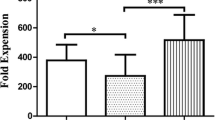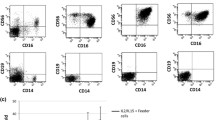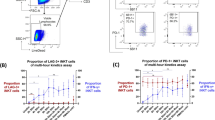Abstract
Background
Invariant natural killer T (iNKT) cells play an important role in tumor immunity, enhancing both innate and acquired immunity. We have previously shown the enhancement of antibody-dependent cellular cytotoxicity against neuroblastoma by activated iNKT cells. As a first step towards clinical application, we studied the frequency and proliferative response of circulating iNKT cells in children with and without cancer.
Methods
Blood samples were collected from 10 patients with pediatric malignant solid tumors and 11 patients with non-neoplastic diseases (control). The frequency of circulating iNKT cells was quantified by flow cytometry. Whole peripheral blood mononuclear cells were then stimulated with α-galactosylceramide (α-GalCer) for 7 days, and the expansion rate of the iNKT-cell fraction was assessed.
Results
The frequency of iNKT cells in the patients of the cancer and control group did not differ to a statistically significant extent. The iNKT-cell population increased after α-GalCer stimulation in all cases. The iNKT cells of patients who had undergone intensive chemotherapy also had the potential to expand in vitro.
Conclusions
Unlike adult cancer patients, the numbers of circulating iNKT cells were not decreased in pediatric cancer patients. α-GalCer stimulation induced a proliferative response in all of the patients.



Similar content being viewed by others
References
Bolande RP (1974) The neurocristopathies: a unifying concept of disease arising in neural crest maldevelopment. Hum Pathol 5:409–429
Brodeur GM, Maris JM (2006) Neuroblastoma. In: Pizzo PA, Poplack DG eds Principles and practice of pediatric oncology, 5th edn. Lippincott Williams & Wilkins, Philadelphia, pp 933–970
Matthay KK, Atkinson JB, Stram DO, Selch M, Reynolds CP, Seeger RC (1993) Patterns of relapse after autologous purged bone marrow transplantation for neuroblastoma: a Childrens Cancer Group pilot study. J Clin Oncol 11:2226–2233
Yu AL, Gilman AL, Ozkaynak MF, London WB, Kreissman SG, Chen HX, Smith M, Anderson B, Villablanca JG, Matthay KK, Shimada H, Grupp SA, Seeger R, Reynolds CP, Buxton A, Reisfeld RA, Gillies SD, Cohn SL, Maris JM, Sondel PM; Children’s Oncology Group (2010) Anti-GD2 antibody with GM-CSF, interleukin-2, and isotretinoin for neuroblastoma. N Engl J Med 363:1324–1334. doi:10.1056/NEJMoa0911123
Svennerholm L, Boström K, Fredman P, Jungbjer B, Lekman A, Månsson JE, Rynmark BM (1994) Gangliosides and allied glycosphingolipids in human peripheral nerve and spinal cord. Biochim Biophys Acta 1214:115–123
Ladenstein R, Pötschger U, Pearson AD, Brock P, Luksch R, Castel V, Yaniv I, Papadakis V, Laureys G, Malis J, Balwierz W, Ruud E, Kogner P, Schroeder H, de Lacerda AF, Beck-Popovic M, Bician P, Garami M, Trahair T, Canete A, Ambros PF, Holmes K, Gaze M, Schreier G, Garaventa A, Vassal G, Michon J, Valteau-Couanet D; SIOP Europe Neuroblastoma Group (SIOPEN) (2017) Busulfan and melphalan versus carboplatin, etoposide, and melphalan as high-dose chemotherapy for high-risk neuroblastoma (HR-NBL1/SIOPEN): an international, randomised, multi-arm, open-label, phase 3 trial. Lancet Oncol. doi:10.1016/S1470-2045(17)30070-0
Nagato K, Motohashi S, Ishibashi F, Okita K, Yamasaki K, Moriya Y, Hoshino H, Yoshida S, Hanaoka H, Fujii S, Taniguchi M, Yoshino I, Nakayama T (2012) Accumulation of activated invariant natural killer T cells in the tumor microenvironment after α-galactosylceramide-pulsed antigen presenting cells. J Clin Immunol 32:1071–1081
Ishikawa A, Motohashi S, Ishikawa E, Fuchida H, Higashino K, Otsuji M, Iizasa T, Nakayama T, Taniguchi M, Fujisawa T (2005) A phase I study of α-galactosylceramide (KRN7000)-pulsed dendritic cells in patients with advanced and recurrent non-small cell lung cancer. Clin Cancer Res 11:1910–1917
Motohashi S, Ishikawa A, Ishikawa E, Otsuji M, Iizasa T, Hanaoka H, Shimizu N, Horiguchi S, Okamoto Y, Fujii S, Taniguchi M, Fujisawa T, Nakayama T (2006) A phase I study of in vitro expanded natural killer T cells in patients with advanced and recurrent nonsmall cell lung cancer. Clin Cancer Res 12:6079–6086
Motohashi S, Nagato K, Kunii N, Yamamoto H, Yamasaki K, Okita K, Hanaoka H, Shimizu N, Suzuki M, Yoshino I, Taniguchi M, Fujisawa T, Nakayama T (2009) A phase I-II study of a-galactosylceramide-pulsed IL-2⁄GM-CSF-cultured peripheral blood mononuclear cells in patients with advanced and recurrent non-small cell lung cancer. J Immunol 182:2492–2501
Kunii N, Horiguchi S, Motohashi S, Yamamoto H, Ueno N, Yamamoto S, Sakurai D, Taniguchi M, Nakayama T, Okamoto Y (2009) Combination therapy of in vitro—expanded natural killer T cells and α-galactosylceramide-pulsed antigen-presenting cells in patients with recurrent head and neck carcinoma. Cancer Sci 100:1092–1098
Yamasaki K, Horiguchi S, Kurosaki M, Kunii N, Nagato K, Hanaoka H, Shimizu N, Ueno N, Yamamoto S, Taniguchi M, Motohashi S, Nakayama T, Okamoto Y (2011) Induction of NKT cell-specific immune responses in cancer tissues after NKT cell-targeted adoptive immunotherapy. Clin Immunol 138:255–265
Mise N, Takami M, Suzuki A, Kamata T, Harada K, Hishiki T, Saito T, Terui K, Mitsunaga T, Nakata M, Ikeuchi T, Nakayama T, Yoshida H, Motohashi S (2016) Antibody-dependent cellular cytotoxicity toward neuroblastoma enhanced by activated invariant natural killer T cells. Cancer Sci 107:233–241. doi:10.1111/cas.12882
Motohashi S, Kobayashi S, Ito T, Magara KK, Mikuni O, Kamada N, Iizasa T, Nakayama T, Fujisawa T, Taniguchi M (2002) Preserved IFN-α production of circulating Vα24 NKT cells in primary lung cancer patients. Int J Cancer 102:159–165
DelaRosa O, Tarazona R, Casado JG, Alonso C, Ostos B, Peña J, Solana R (2002) Vα24+ NKT cells are decreased in elderly humans. Exp Gerontol 37:213–217
Peralbo E, DelaRosa O, Gayoso I, Pita ML, Tarazona R, Solana R (2006) Decreased frequency and proliferative response of invariant Vα24Vβ11 natural killer T (iNKT) cells in healthy elderly. Biogerontology 7:483–492
Molling JW, Kölgen W, van der Vliet HJ, Boomsma MF, Kruizenga H, Smorenburg CH, Molenkamp BG, Langendijk JA, Leemans CR, von Blomberg BM, Scheper RJ, van den Eertwegh AJ (2005) Peripheral blood IFN-γ-secreting Vα24+Vβ11+ NKT cell numbers are decreased in cancer patients independent of tumor type or tumor load. Int J Cancer 116:87–93
Almand B, Clark JI, Nikitina E, van Beynen J, English NR, Knight SC, Carbone DP, Gabrilovich DI (2001) Increased production of immature myeloid cells in cancer patients: a mechanism of immunosuppression in cancer. J Immunol 166:678–689
Menetrier-Caux C, Montmain G, Dieu MC, Bain C, Favrot MC, Caux C, Blay JY (1998) Inhibition of the differentiation of dendritic cells from CD34 progenitors by tumor cells: role of interleukin-6 and macro- phage colony-stimulating factor. Blood 92:4778–4791
Chouaib S, Asselin-Paturel C, Mami-Chouaib F, Caignard A, Blay JY (1997) The host–tumor immune conflict: from immunosuppression to resistance and destruction. Immunol Today 18:493–497
Mizoguchi H, O’Shea JJ, Longo DL, Loeffler CM, McVicar DW, Ochoa AC (1992) Alterations in signal transduction molecules in T lymphocytes from tumor-bearing mice. Science 258:1795–1798
Molling JW, Langius JA, Langendijk JA, Leemans CR, Bontkes HJ, van der Vliet HJ, von Blomberg BM, Scheper RJ, van den Eertwegh AJ (2007) Low levels of circulating invariant natural killer T cells predict poor clinical outcome in patients with head and neck squamous cell carcinoma. J Clin Oncol 25:862–868
Tahir SM, Cheng O, Shaulov A, Koezuka Y, Bubley GJ, Wilson SB, Balk SP, Exley MA (2001) Loss of IFN-γ production by invariant NK T cells in advanced cancer. J Immunol 167:4046–4050
Kawano T, Nakayama T, Kamada N, Kaneko Y, Harada M, Ogura N, Akutsu Y, Motohashi S, Iizasa T, Endo H, Fujisawa T, Shinkai H, Taniguchi M (1999) Antitumor cytotoxicity mediated by ligand-activated human Vα24 NKT cells. Cancer Res 59:5102–5105
de Gast GC, Verdonck LF, Middeldorp JM, The TH, Hekker A, vd Linden JA, Kreeft HA, Bast BJ (1985) Recovery of T cell subsets after autologous bone marrow transplantation is mainly due to proliferation of mature T cells in the graft. Blood 66:428–431
Mackall CL, Fleisher TA, Brown MR, Magrath IT, Shad AT, Horowitz ME, Wexler LH, Adde MA, McClure LL, Gress RE (1994) Lymphocyte depletion during treatment with intensive chemotherapy for cancer. Blood 84:2221–2228
Grupp SA, Prak EL, Boyer J, McDonald KR, Shusterman S, Thompson E, Callahan C, Jawad AF, Levine BL, June CH, Sullivan KE (2012) Adoptive transfer of autologous T cells improves T-cell repertoire diversity and long-term B-cell function in pediatric patients with neuroblastoma. Clin Cancer Res 18:6732–6741. doi:10.1158/1078-0432.CCR-12-1432
Acknowledgements
This work was supported by Grants from the Ministry of Education, Culture, Sports, Science and Technology Grant-in-Aid for Scientific Research (C) Number 235926242.
Author information
Authors and Affiliations
Corresponding author
Ethics declarations
Conflict of interest
The authors declare no conflicts of interest in association with the present study.
Informed consent
All analyses were performed in accordance with the Declaration of Helsinki and were approved by the institutional review board. Informed consent for the usage of surplus tumor tissue was obtained from the human subjects who participated in this study.
Rights and permissions
About this article
Cite this article
Hishiki, T., Mise, N., Harada, K. et al. Frequency and proliferative response of circulating invariant natural killer T cells in pediatric patients with malignant solid tumors. Pediatr Surg Int 34, 169–176 (2018). https://doi.org/10.1007/s00383-017-4185-1
Accepted:
Published:
Issue Date:
DOI: https://doi.org/10.1007/s00383-017-4185-1




